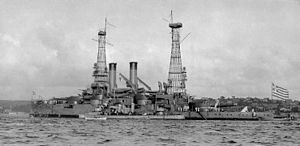 Lemnos – Θ/Κ Λήμνος
| |
| History | |
|---|---|
| Name | Idaho |
| Namesake | Idaho |
| Builder | William Cramp & Sons, Philadelphia |
| Laid down | 12 May 1904 |
| Launched | 9 December 1905 |
| Commissioned | 1 April 1908 |
| Identification | Hull number: BB-24 |
| Fate | Sold to Greece, 1914 |
| Name | Lemnos |
| Namesake | Battle of Lemnos |
| Commissioned | 22 July 1914 |
| Decommissioned | 1932 |
| Fate | Sunk on April 23, 1941 near Salamis |
| General characteristics | |
| Class and type | Mississippi-class battleship |
| Displacement | |
| Length | 382 ft (116.4 m) |
| Beam | 77 ft (23.5 m) |
| Draft | 24 ft 8 in (7.5 m) |
| Installed power |
|
| Propulsion | |
| Speed | 17 knots (20 mph; 31 km/h) |
| Crew | 744 |
| Armament |
|
| Armor |
|
Lemnos, sometimes spelled Limnos (Greek: Θ/Κ Λήμνος), was a 13,000 ton Mississippi-class battleship originally built by the United States Navy in 1904–1908. As USS Idaho (BB-24), she was purchased by the Greek Navy in 1914 and renamed Lemnos, along with her sister Mississippi, renamed Kilkis. Lemnos was named for the Battle of Lemnos, a crucial engagement of the First Balkan War. Armed with a main battery of four 12 in (305 mm) guns, Lemnos and her sister were the most powerful vessels in the Greek fleet.
The ship saw limited action during World War I. Greece's pro-German monarch, Constantine I opted to remain neutral until October 1916, when pressure from the Triple Entente forced him to abdicate in favor of a pro-Entente government. For the remainder of the war, Lemnos operated solely as a harbor defense ship. In the aftermath of World War I, she saw service during the Allied intervention in the Russian Civil War and the Greco-Turkish War of 1919–1922. During the war with Turkey, Lemnos supported Greek landings in Turkey and participated in the final Greek sea-borne withdrawal in 1922. She remained in service until 1932, when she was used as a barracks ship and subsequently disarmed. During the German invasion of Greece in 1941, she and her sister were sunk in Salamis by German Junkers Ju 87 dive bombers. The two ships were ultimately raised and broken up for scrap after the end of the war.